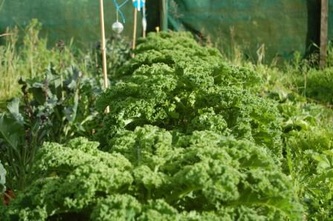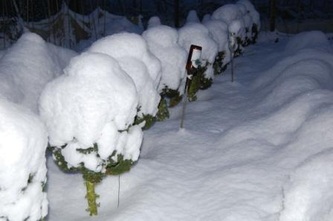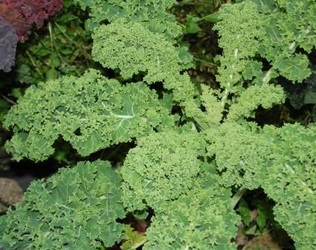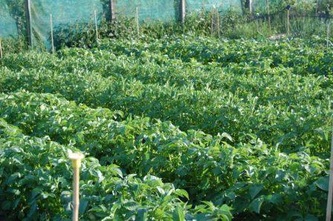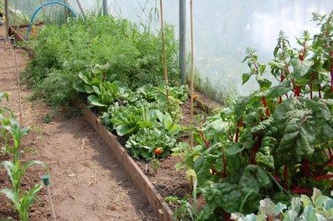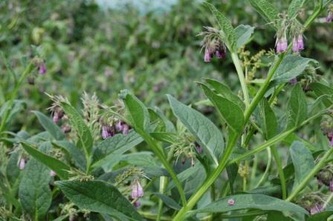Our Vegetable Garden
Growing vegetables at 1000' above sea level on a windy hillside was never going to be easy. The hedgerows we have planted have made a big difference, cutting down some of the wind and creating a gentler micro climate. We erected a windbreak of mesh around the vegetable garden when we first ploughed it, while waiting for the hedges to grow. We knew that some crops would never grow outdoors here so putting up a polytunnel was a priority and this was soon followed by a greenhouse - inside the polytunnel. The high winds here would mean that a normal greenhouse would blow away regularly, but inside the tunnel it gets protection from the wind and young or tender plants get an extra degree of protection from the cold.
We are lucky to be on an old volcanic ridge, between Tinto Hill and the Black Mount, so our soil is wonderful - fertile and free draining. We use well-rotted manure from our sheep and poultry to add fertility and humous to the soil. All this richness means that our weeds are super-sized and prolific and we spend a large part of our time battling them. The wonderful crops we grow for the kitchen make it all worthwhile.
Inside the tunnel we grow tomatoes, cucumbers, chillis and peppers as you would expect. In addition Runner and French climbing beans, sweetcorn, courgettes and squashes all need to be grown under cover as they don't do well in the wind and the cold, wet springs we usually get. Sometimes we grow some outside as an experiment but they don't crop, even if they grow well initially. Peas on the other hand seem to hate the tunnel and prefer to take their chances with the gales. We grow salad crops both outside and inside, depending on the season and some years they do better outside but in others such as this year they have been badly damaged by slugs outside so indoor crops have done better.
Growing vegetables at 1000' above sea level on a windy hillside was never going to be easy. The hedgerows we have planted have made a big difference, cutting down some of the wind and creating a gentler micro climate. We erected a windbreak of mesh around the vegetable garden when we first ploughed it, while waiting for the hedges to grow. We knew that some crops would never grow outdoors here so putting up a polytunnel was a priority and this was soon followed by a greenhouse - inside the polytunnel. The high winds here would mean that a normal greenhouse would blow away regularly, but inside the tunnel it gets protection from the wind and young or tender plants get an extra degree of protection from the cold.
We are lucky to be on an old volcanic ridge, between Tinto Hill and the Black Mount, so our soil is wonderful - fertile and free draining. We use well-rotted manure from our sheep and poultry to add fertility and humous to the soil. All this richness means that our weeds are super-sized and prolific and we spend a large part of our time battling them. The wonderful crops we grow for the kitchen make it all worthwhile.
Inside the tunnel we grow tomatoes, cucumbers, chillis and peppers as you would expect. In addition Runner and French climbing beans, sweetcorn, courgettes and squashes all need to be grown under cover as they don't do well in the wind and the cold, wet springs we usually get. Sometimes we grow some outside as an experiment but they don't crop, even if they grow well initially. Peas on the other hand seem to hate the tunnel and prefer to take their chances with the gales. We grow salad crops both outside and inside, depending on the season and some years they do better outside but in others such as this year they have been badly damaged by slugs outside so indoor crops have done better.
Scenes from the veggie patch
Winters up here can be harsh and plants which are normally described as being very hardy can succumb. For example the brassicas shown above were soon covered with a couple of feet of snow which lay for weeks and weeks, with temperatures down to -20C. When the snow melted the plants had turned to mush. People living in harsher climates than we have presumably manage to grow their vegetables so we must learn their secrets.
We have tried various strategies against the weeds. Neither of us can dig for very long so we have a couple of rotavators, one for general soil preparation and a small one for working in manure and weeding between the rows. We don't have the kind of bed system which the media show as necessary, except for the occasional small salad bed in the tunnel. Outdoors we have devised a system of flat beds covered with weed suppressing fabric, as shown above, left. Weeds do still poke through the planting holes but overall the system works fairly well. This year we have covered the paths between beds as well as they got very weedy last year. This is what gardening is all about - learning from experience and adapting where necessary. We had hoped that the fabric would last for several years but if it is out over the winter then it tears too badly to use again, so is an expensive option, but is far cheaper than buying the wood to make raised beds.
